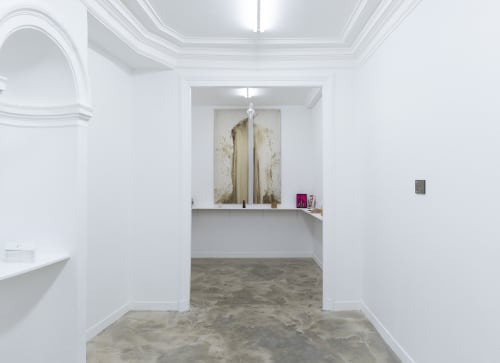ODORE L'ART, L'ODEUR ET LE SACRÉ: COMMISSARIAT SANDRA BARRÉ
Christelle Boulé - Sarkis - Marcel Duchamp et Mathieu Mercier - Romain Vicari - Julie C. Fortier - Quentin Derouet - Joseph Beuys - ORLAN - hermann nitsch - Hratch Arbach - Roman Moriceau - Boris Raux - Gwenn-Aël Lynn - Jana Sterbak - Claudia Vogel - Peter de Cupere - Antoine Renard - Sarah Trouche
En 1919, Marcel Duchamp offrait à son ami et mécène Walter Arensberg, l’Air de Paris enfermé dans une ampoule. Par ce geste, par ce ready-made où ce que l’on inhale est déterminé et porté au rang d’art, l’artiste français, père de l’art contemporain, ouvre la voie à une sacralisation plastique de ce qui se respire et s’établit : l’effluve. En la choisissant comme médium, en lui per- mettant l’entrée au panthéon des matériaux explorés par le vingtième siècle, Duchamp met en lumière combien la valeur artistique de l’odeur est estimable. Immatériel précieux, elle révèle les émotions, ravive la mémoire et lie ce qui s’hume à la grande tradition du sacré.
Dans Odore, les œuvres présentées, toutes référant aux émanations, dessinent un voyage in- trospectif et interrogent la première attache qui a ramené les exhalaisons tout près des êtres humains, leur prédisant l’accessibilité à un autre monde. Les Grec.que.s et les Romain.e.s cou- vraient leurs statues d’onctions, laissant aux effluves le soin d’envoyer leurs prières au divin; les sorcières et les herboristes manipulaient les plantes en extrayant leurs essences ; les chamans chargeaient les fumées de la promesse d’une traversée mystique.
Les artistes contemporain.e.s, magicien.ne.s et alchimistes d’aujourd’hui, voient leur pratique et leur personne entrer en résonance avec la sacralisation des institutions culturelles. Le musée devenu lieu de pèlerinage sanctifie l’artiste, qui semble pouvoir y être accueilli en odeur de sainteté. Alors, le lien au sacré se fait par une forme de mystification de l’œuvre et de son.sa créateur.rice et certains travaux odorants aux allures autobiographiques, pourraient être observés comme de véritables reliques.
Cette notion de relique olfactive s’envisage également par des morceaux de chairs qui rappellent des instants vécus, qui poussent à éprouver et qui destinent à ressentir. Car l’odeur permet l’évocation, une évocation intime, viscérale, qu’il n’est pas nécessaire de verbaliser, mais que l’on porte en soi, que l’on chérit, comme on le ferait des croyances, des prières et des souvenirs olfactifs personnels qui tissent la grande histoire.
Sandra Barré
In 1919, Marcel Duchamp gave his friend and patron Walter Arensberg Air de Paris enclosed in a light bulb. With this gesture, this ready-made in which what we inhale is determined and elevated to the status of art, the French artist, the father of contemporary art, opened the way to a plastic sacralisation of what is breathed in and established: effluence. By choosing it as a medium, by allowing it to enter the pantheon of materials explored by the twentieth century, Duchamp highlighted the extent to which the artistic value of smell is estimable. A precious immaterial, it reveals emotions, revives memories and links what is smelt to the great tradition of the sacred.
In Odore, the works presented, all referring to emanations, outline an in- trospective journey and question the first attachment that brought exhalations close to human beings, predicting their accessibility to another world. The Greeks and Romans covered their statues with anointments, leaving the effluvia to send their prayers to the divine; witches and herbalists manipulated plants by extracting their essences; shamans charged the fumes with the promise of a mystical journey.
Contemporary artists, today's magicians and alchemists, see their practice and their person resonate with the sacralisation of cultural institutions. The museum, now a place of pilgrimage, sanctifies the artist, who seems to be welcomed there in the odour of sanctity. So the link to the sacred is made through a form of mystification of the work and its creator, and certain fragrant works with an autobiographical allure could be observed as veritable relics.
This notion of olfactory relics can also be envisaged in terms of pieces of flesh that recall past moments, that encourage us to feel and to experience. Because scent is an evocation, an intimate, visceral evocation that we don't need to verbalise, but that we carry within us, that we cherish, as we would beliefs, prayers and personal olfactory memories that weave the great story.
Sandra Barré






